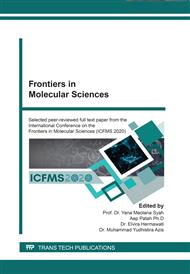p.107
p.115
p.128
p.136
p.143
p.149
p.155
p.165
p.171
Quantitative Structure-Property Relationship (QSPR) Study on the Complex Compounds Formed From Gadolinium(III) with Dibutyl Dithiophosphate Derivatives Ligands Based on Molecular Descriptors
Abstract:
A study of the quantitative relationship of structure and property (Quantitative Structure Property Relationship (QSPR) has been carried out on complex compounds formed between gadolinium (Gd) and dibutyldithiophosphate (DBDTP) derivative ligands. This study is a part of our laboratory research program on the development of extractant ligands, including DBDTP in extraction for the separation and purification of rare-earth elements (REEs), specifically Gd. Gadolinium has also been a part of the research program about its use in the synthesis of magnetic resonance imaging (MRI) contrast agents, for the diagnosis of various diseases. This chemical calculation research aims to analyze the effect of descriptors in the form of parameters of the physical-chemical properties of bond lengths, bond angles, and bond energies on the stability of Gd complex compounds with DBDTP derivative ligands. To get descriptors PM7 semi-empirical method was used, while for data analysis, Multiple Linear Regression Analysis was used, assuming the model error is normally distributed with zero mean and constant variance. Furthermore, data processing was done using SPSS software. This research was conducted by involving 28 DBDTP derivative ligands and using multiple linear regression analysis. The regression equation is Y ̂ = - 0.966 + 0.586 V1 - 0.014 V2 + 0.000 V3. From the resulted research data it was found that there are three findings, namely: (1) bond length and bond angle have a significant simultaneous effect on stability of Gd complex compounds with DBDTP derivative ligands; (2) bond length and bond angle have a partially significant effect on stability of Gd complex compounds with DBDTP derivative ligands; (3) bond length proved to have a significant dominant effect on stability of Gd complex compounds with DBDTP derivative ligands.
Info:
Periodical:
Pages:
171-181
Citation:
Online since:
January 2021
Price:
Сopyright:
© 2021 Trans Tech Publications Ltd. All Rights Reserved
Share:
Citation:


